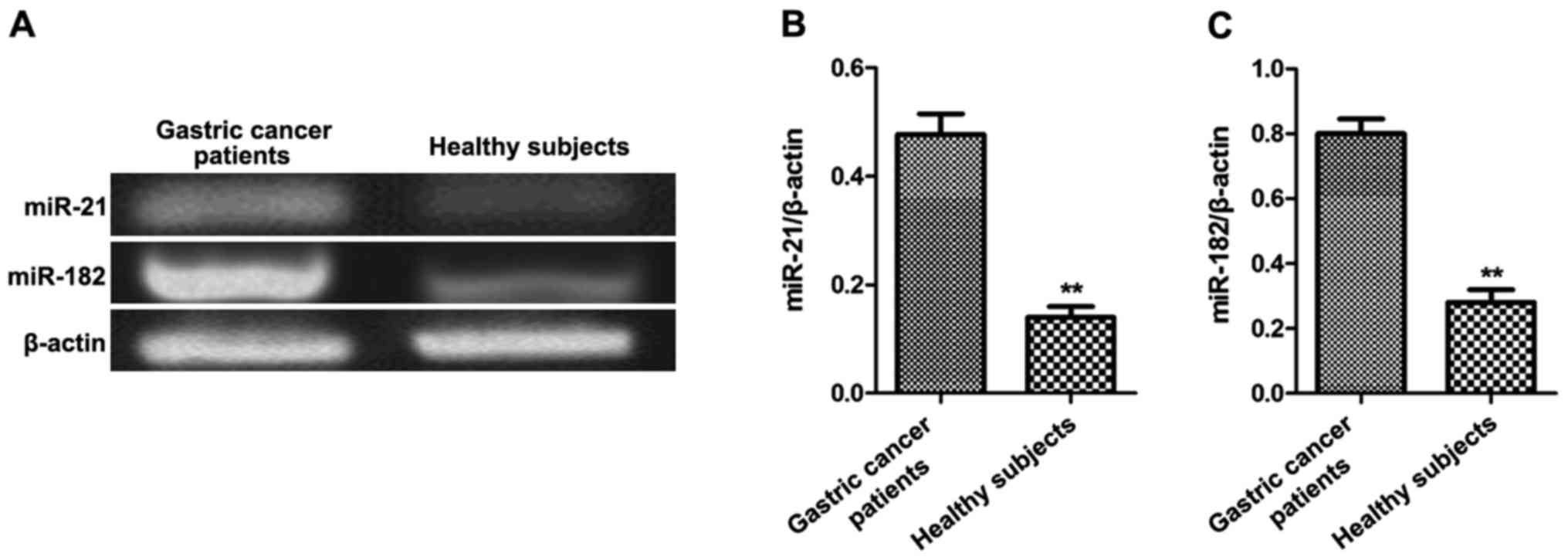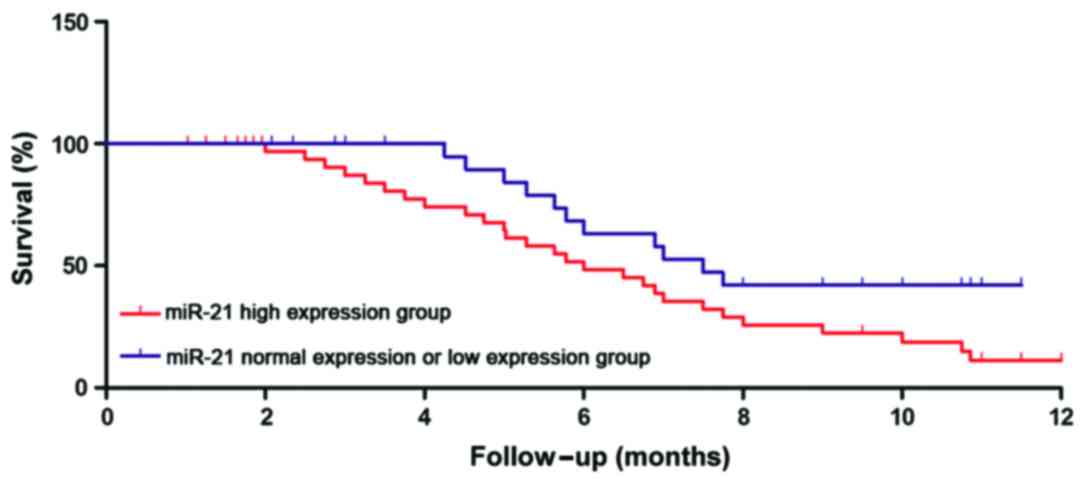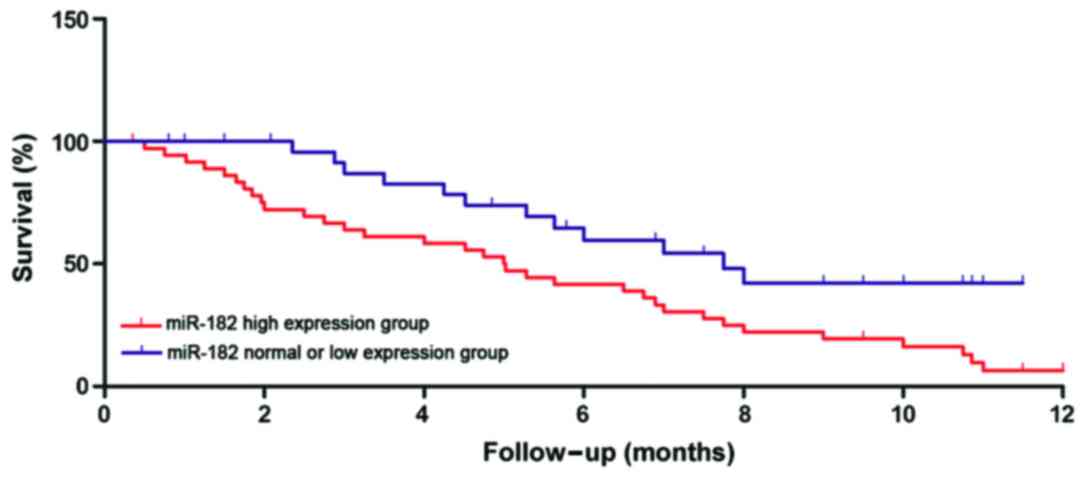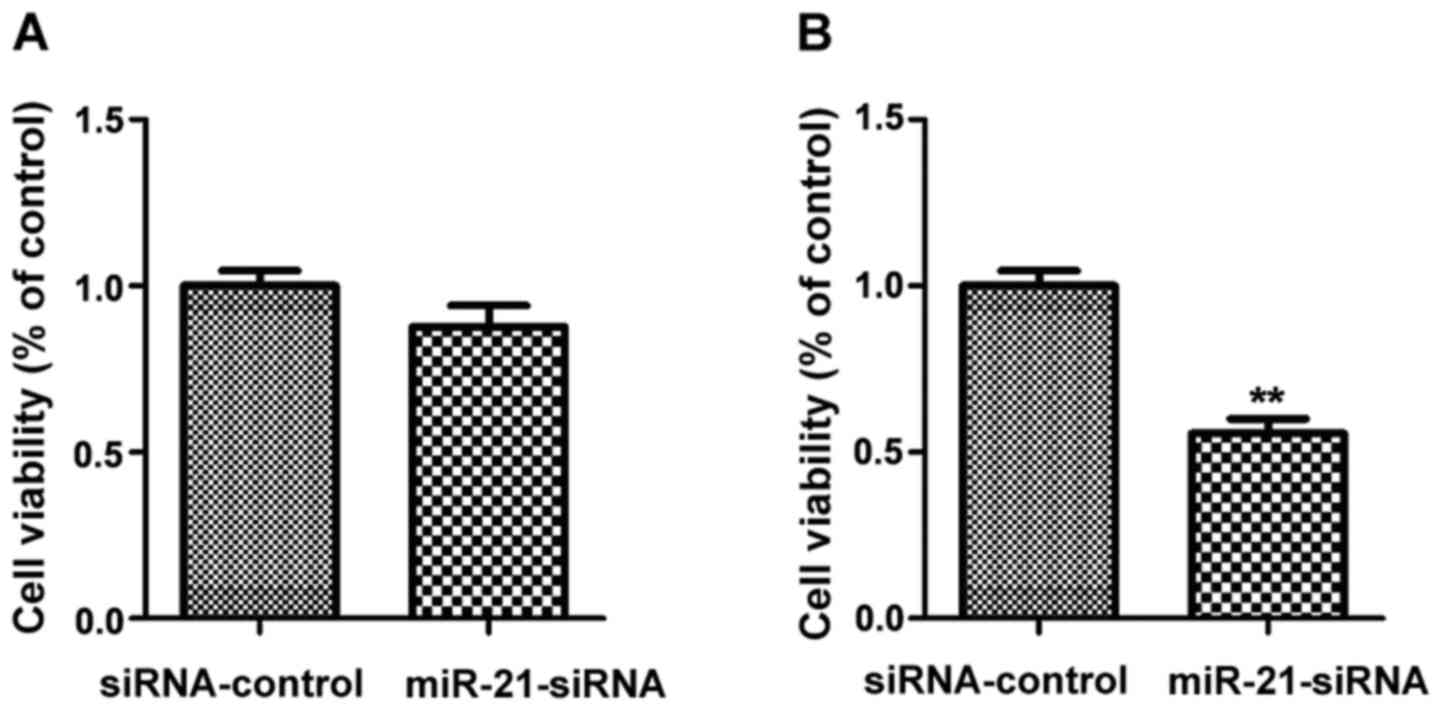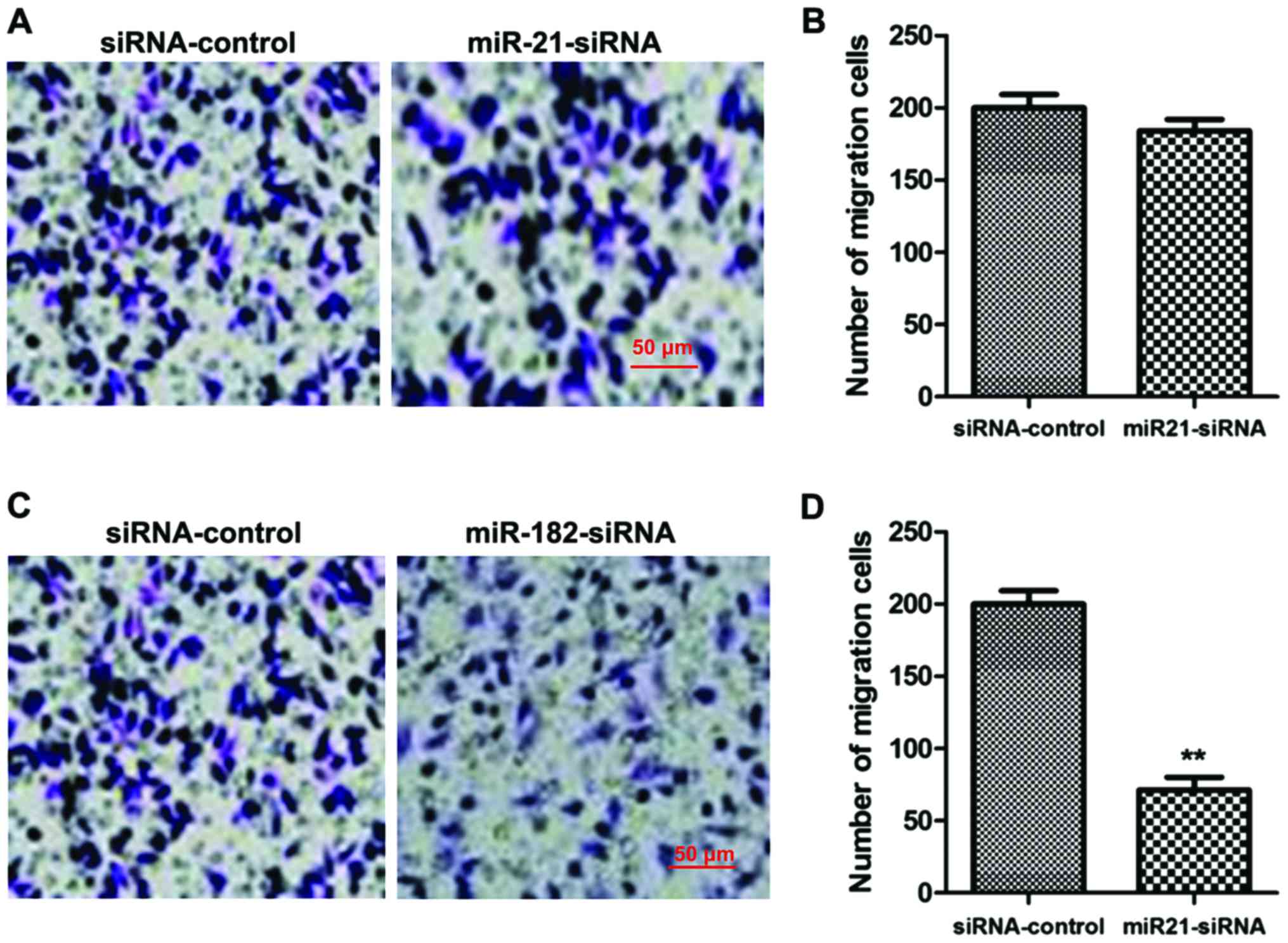Relationship between miR-21 and miR-182 levels in peripheral blood and gastric cancer tissue
- Authors:
- Published online on: May 30, 2017 https://doi.org/10.3892/ol.2017.6280
- Pages: 1427-1432
-
Copyright: © Wang et al. This is an open access article distributed under the terms of Creative Commons Attribution License.
Abstract
Introduction
Multiple factors are involved in the occurrence of gastric cancer, among which poor eating habits are a high risk factor (1,2). With the development of medical technology, both the detection and treatment rate of cancer have increased significantly. However, when diagnosis of gastric cancer in older patients is confirmed, it has generally developed into a progressive stage with metastasis, resulting in a low cure rate when chemotherapy is applied for treatment (3,4). With developments of molecular biology, microRNA (miRNA) has gradually become an area of intense research in medicine and life science. A large number of studies have confirmed that miRNA is closely associated with the occurrence and development of multiple cancers (5,6). The study by Gadducci et al (7) showed that overexpression of miR-21 can significantly increase the incidence of ovarian cancer, and the clinical use of drugs to block miR-21 expression can significantly increase the survival time of patients. Zhang et al (8) found that the level of miR-21 expression affects the occurrence and development of breast cancer, and high expression of miR-182 is closely related to the proliferation and migration of breast cancer cells. However, there are no reports on the relationship between miR-21 and miR-182 expression and gastric cancer.
By detecting the expression of the miR-21 and miR-182 genes in gastric cancer tissue, and investigating the relationship between miR-21 and miR-182 expression levels and clinicopathological features as well as prognosis of gastric cancer patients, we aimed to determine the relationship between the occurrence and development of gastric cancer and miR-21 and miR-182 expression, to provide a new basis for the clinical treatment of gastric cancer.
Materials and methods
Patients
A total of 50 patients who were admitted to the 254th Hospital of PLA, and definitely diagnosed with gastric cancer by pathological examination after surgical resection from July 2012 to July 2014 were selected. The patients were aged 48–77 years. There were 28 males and 22 females. Other consumptive diseases were excluded, and all patients signed the informed consent. The included patients had complete clinical and pathological data. Simultaneously, 50 healthy subjects without gastric cancer, who underwent physical examinations during the same period, were selected as the control group. Patients had 1 year of follow-up and all treatment schemes were recorded. Peripheral blood samples were collected from patients and stored in liquid nitrogen. This study was approved by the Ethics Committee of 254th Hospital of PLA. Signed written informed consents were obtained from all participants before the study.
Instruments and reagents
MGC-803 cell line (Kunming Cell Bank of the Chinese Academy of Sciences, Shanghai, China), methyl thiazolyl tetrazolium (MTT) (Sigma, St. Louis, MO, USA), dimethylsulphoxide (DMSO) (Sigma), Transwell chambers (Millipore Corp., Billerica, MA, USA), TRIzol kit (Invitrogen, Carlsbad, CA, USA), reverse transcription kit (Invitrogen), β-actin antibody (Sigma), fluorescence inverted microscope (Thermo Fisher Scientific, Darmstadt, Germany), cell culture bottles (Corning, Costar, Inc., Corning, NY, USA), transferpettor (Eppendorf AG, Hamburg, Germany), PCR instrument (Applied Biosystems Life Technologies, Foster City, CA, USA) and ultraviolet imaging system (Biometra, GmbH, Goettingen, Germany).
Detecting miR-21 and miR-182 expression in peripheral blood of gastric cancer patients by semi-quantitative PCR
Peripheral blood samples were collected from gastric cancer patients and healthy subjects, followed by centrifugation at 3,500 × g for 10 min. Next, the supernatant was collected, and total RNA was extracted with a TRIzol kit. The integrity of RNA was confirmed by agarose gel electrophoresis, which showed that the bands corresponding to 28S, 18S, and 5S RNA were clear. The 28S band was twice as bright as the 18S band, suggesting that RNA was of high integrity, and could be used for follow-up experiments. Subsequently, reverse transcription was conducted to obtain cDNA using a reverse transcription kit. miR-21 and miR-182 expression in peripheral blood was measured by semi-quantitative PCR, with β-actin as the internal reference. The reaction conditions were as follows: 95°C for 30 sec, 64°C for 25 sec, and 72°C for 30 sec, for a total of 35 cycles. Primers were synthesized by Tiangen Biotech (Beijing) Co., Ltd., (Beijing, China), and the sequences are shown in Table I. Agarose gel electrophoresis was performed after the reaction, and the products were observed by an ultraviolet imaging system.
Establishment of miR-21 and miR-182 low expression cell lines
miR21-siRNA, miR182-siRNA, and the corresponding control sequences were designed and synthesized by ToYoBo Co., Ltd., (Osaka, Japan). MGC-803 cells under healthy growth conditions were transfected by the aforementioned synthetic si-RNA. After 48 h of transfection, RNA was extracted and reverse transcription was performed to obtain cDNA. PCR was adopted to detect the levels of miR-21 and miR-182 in cells. When the transfection was successful, the expression of miR-21 and miR-182 was significantly reduced. The successfully transfected cells were selected and divided into three groups: the miR21-siRNA, miR182-siRNA and siRNA-control group. These cells were cultured in an incubator (37°C, 5% CO2) and prepared for follow-up experiments.
MTT assay
The effects of low expression of miR-21 and miR-182 on the growth of gastric cancer cells were investigated by MTT assay. MTT (5 mg/ml) was prepared. A total of 3×104/ml cells were seeded in 96-well plates for continuous culture in the incubator for 48 h, followed by the addition of MTT for further culture. After 4 h, the culture medium was discarded, and DMSO was added. MTT and cells were fully combined via shock treatment. The absorbance value at 570 nm was measured with a microplate reader (Eppendorf AG) (9).
Transwell assay
The effects of low expression of miR-21 and miR-182 on the migration of gastric cancer cells were investigated by Transwell assay. Cells were starved for 24 h. Cell number was adjusted to 5×105/ml, and cells were added to Transwell chambers. After staining and fixation, the number of cells that passed through the chamber was calculated by microscopic examination (10).
Statistical analysis
Data are presented as mean ± standard deviation. SPSS19.0 software (SPSS, Inc., Chicago, IL, USA) was used for data analysis. The t-test was adopted for numerical data; intergroup comparisons of categorical data were by chi-square test; the correlations between miRNA expression level and clinicopathological features were analyzed by a correlation analysis software program; the Kaplan-Meier method was used for survival analysis, followed by Log-rank test. P≤0.05 was considered statistically significant.
Results
Expression of miR-21 and miR-182 in gastric cancer patients
Peripheral blood samples were collected from gastric cancer patients and healthy subjects (n=50 each). The levels of the miR-21 and miR-182 genes were detected by semi-quantitative PCR. The relative levels of miR-21 and miR-182 in peripheral blood of gastric cancer patients were significantly higher than those of healthy subjects (p<0.01, Fig. 1).
Relationship between miR-21 and miR-182 expression and clinicopathological features as well as prognosis of patients
The relative levels of miR-21 and miR-182 in peripheral blood of gastric cancer patients were determined by semi-quantitative PCR. The relative levels as well as the age, tumor size, clinical staging, and other clinical features of gastric cancer patients were analyzed. As shown in Table II, there was no correlations between the relative level of miR-21 in peripheral blood of gastric cancer patients and age, tumor size, TNM staging, lymphatic metastasis and recurrence (p>0.05); the relative level of miR-182 had no correlation with the age of gastric cancer patients (p=0.0682), but it was closely related to tumor size, TNM staging, lymphatic metastasis, and recurrence (p<0.01). According to the relative levels of miR-21 and miR-182, the follow-up data of patients were divided into a high expression group and normal expression or low expression group. The survival time of the two groups was statistically analyzed, showing that the survival times of patients in the miR-21 and miR-182 high expression groups were significantly shorter than those of patients in the normal expression or low expression groups (p<0.01). Survival curves are shown in Figs. 2 and 3.
Table II.Relationship between the relative expression levels of miR-21 and miR-182 and clinical features of patients. |
Establishment of MGC-803 cell lines with low expression of miR-21 and miR-182
The levels of miR-21 and miR-182 in MGC-803 gastric cancer cells were downregulated by siRNA transfection, and RNA was extracted. After reverse transcription, RNA expression was measured by semi-quantitative PCR. As shown in Fig. 4, compared with the siRNA-control group, miR-21 expression in cells of the miR21-siRNA group was decreased to 17.82±3.42% (p<0.01), and miR-182 expression in cells of the miR182-siRNA group was decreased to 23.67±5.83% (p<0.01), suggesting that MGC-803 cell lines with low expression of miR-21 and miR-182 were established.
Effect of low expression of miR-21 and miR-182 on cell proliferation
The successfully transfected MGC-803 cells with low expression of miR-21 or miR-182 were used to investigate the effects of miR-21 and miR-182 on cell proliferation. The quantity of MGC-803 cells was assessed by MTT assay (Fig. 5). Compared with the siRNA-control group, there was no obvious change in the quantity of cells in the miR21-siRNA group (p>0.05); compared with the siRNA-control group, the quantity of cells in the miR182-siRNA group was significantly decreased (p<0.01).
Effect of low expression of miR-21 and miR-182 on cell migration
The successfully transfected MGC-803 cells with low expression of miR-21 or miR-182 were used to investigate the effects of miR-21 and miR-182 on cell migration. The migration of gastric cancer cells was analyzed by Transwell assay (Fig. 6). Compared with the siRNA-control group, there was no evident change in migration ability of cells in the miR21-siRNA group (p>0.05); however, compared with the siRNA-control group, the migration ability of cells in the miR182-siRNA group was significantly decreased (p<0.01).
Discussion
The effects of miRNA on human pathological and physiological processes are regulated primarily through gene transcription and translation (11). By affecting transcription and translation, miRNA can cause the abnormal metabolism of tumor cells (12). The abnormal proliferation and migration of tumor cells can be caused by high expression of miRNA, indicating that miRNA may play a role in promoting cancer. In contrast, some miRNA have been shown to suppress cancer (13). Studies on miRNA have shown that the expression of miR-182 is significantly higher in multiple tumor cells compared with normal tissues (14–16). The study by Mirzaei et al (17) indicated that when miR-182 is highly expressed in tumor cells, the metastatic potential of tumors is significantly higher than tumor cells with low expression or normal expression of miR-182. Using an animal model of sarcoma, Gadducci et al (7) also found that the proliferation and migration of tumor cells are affected by miR-182; when miR-182 is knocked out, the proliferation and migration ability of tumor cells are significantly decreased. At present, there is little research on miR-21. Petrović (18) found that there is a close correlation between miR-21 and renal carcinoma. Patients with a high expression of miR-21 may have a significantly increased risk of renal carcinoma, and miR-21 can induce the occurrence of renal carcinoma.
In the present study, we investigated the relationship between miR-21 and miR-182 expression levels and the occurrence and development of gastric cancer. This was achieved by collecting peripheral blood from gastric cancer patients, while using peripheral blood samples from healthy subjects as controls. The levels of miR-21 and miR-182 were closely related to the occurrence of gastric cancer. Therefore, the occurrence of gastric cancer may be regulated by the levels of miR-21 and miR-182. Huang et al (19) indicated that the levels of miR-21 and miR-182 in plasma were equivalent to those in tumor tissues; the levels of miR-21 and miR-182 in peripheral blood alone can be used to assess the levels of these genes in tumor tissue samples. Therefore, collecting peripheral blood from patients with gastric cancer as samples for analysis has the advantages of minimal trauma, convenient to obtain, and strong acceptability by patients, and shows great application potential for the preliminary screening of gastric cancer patients. The relationship between the relative levels of miR-21 and miR-182 and clinicopathological features as well as survival time of patients with gastric cancer indicated that miR-182 was closely related to tumor size, TNM staging, lymphatic metastasis, and recurrence of gastric cancer. miR-182 can regulate both the occurrence and development of gastric cancer. Furthermore, the effects of low expression of miR-182 on proliferation and migration ability of gastric cancer cells were investigated by MTT and Transwell assay, respectively. The results indicated that low expression of miR-182 significantly reduced the proliferation and migration ability of gastric cancer cells. There was no correlation between miR-21 and each clinicopathological feature, but high expression of miR-2 affected the survival time of patients, suggesting that miR-21 can affect the occurrence of gastric cancer and the survival time of patients. However, it had no direct correlation with the differentiation and severity of gastric cancer. Currently, it is unclear through which signaling proteins miR-21 and miR-182 affect gastric cancer. This will be the focus of future research.
In conclusion, peripheral blood can be used to measure the levels of miR-21 and miR-182. The relative levels of miR-21 and miR-182 can be used as molecular markers for screening gastric cancer, and will promote the identification of new targets and ideas for the treatment of gastric cancer in clinical practice.
References
|
Petrovchich I and Ford JM: Genetic predisposition to gastric cancer. Semin Oncol. 43:554–559. 2016. View Article : Google Scholar : PubMed/NCBI | |
|
Payão SL and Rasmussen LT: Helicobacter pylori and its reservoirs: A correlation with the gastric infection. World J Gastrointest Pharmacol Ther. 7:126–132. 2016. View Article : Google Scholar : PubMed/NCBI | |
|
Cover TL: Helicobacter pylori diversity and gastric cancer risk. MBio. 7:e01869–e15. 2016. View Article : Google Scholar : PubMed/NCBI | |
|
Oue T, Koshinaga T, Takimoto T, Okita H, Tanaka Y, Nozaki M, Haruta M, Kaneko Y and Fukuzawa M; Renal Tumor Committee of the Japanese Childrens Cancer Group, : Anaplastic histology Wilms tumors registered to the Japan Wilms Tumor Study Group are less aggressive than that in the National Wilms Tumor Study 5. Pediatr Surg Int. 32:851–855. 2016. View Article : Google Scholar : PubMed/NCBI | |
|
Barwari T, Joshi A and Mayr M: MicroRNAs in cardiovascular disease. J Am Coll Cardiol. 68:2577–2584. 2016. View Article : Google Scholar : PubMed/NCBI | |
|
Garg M: Targeting microRNAs in epithelial-to-mesenchymal transition-induced cancer stem cells: Therapeutic approaches in cancer. Expert Opin Ther Targets. 19:285–297. 2015. View Article : Google Scholar : PubMed/NCBI | |
|
Gadducci A, Sergiampietri C, Lanfredini N and Guiggi I: Micro-RNAs and ovarian cancer: The state of art and perspectives of clinical research. Gynecol Endocrinol. 30:266–271. 2014. View Article : Google Scholar : PubMed/NCBI | |
|
Zhang QH, Sun HM, Zheng RZ, Li YC, Zhang Q, Cheng P, Tang ZH and Huang F: Meta-analysis of microRNA-183 family expression in human cancer studies comparing cancer tissues with noncancerous tissues. Gene. 527:26–32. 2013. View Article : Google Scholar : PubMed/NCBI | |
|
Hufnagel RB, Zimmerman SL, Krueger LA, Bender PL, Ahmed ZM and Saal HM: A new frontonasal dysplasia syndrome associated with deletion of the SIX2 gene. Am J Med Genet A 170A. 1–491. 2016. | |
|
Berasain C, Perugorria MJ, Latasa MU, Castillo J, Goñi S, Santamaría M, Prieto J and Avila MA: The epidermal growth factor receptor: A link between inflammation and liver cancer. Exp Biol Med (Maywood). 234:713–725. 2009. View Article : Google Scholar : PubMed/NCBI | |
|
Matsuda A, Yan IK, Foye C, Parasramka M and Patel T: MicroRNAs as paracrine signaling mediators in cancers and metabolic diseases. Best Pract Res Clin Endocrinol Metab. 30:577–590. 2016. View Article : Google Scholar : PubMed/NCBI | |
|
Nassar FJ, Nasr R and Talhouk R: MicroRNAs as biomarkers for early breast cancer diagnosis, prognosis and therapy prediction. Pharmacol Ther. 36:7591–7598. 2016. | |
|
Williams J, Smith F, Kumar S, Vijayan M and Reddy PH: Are microRNAs true sensors of ageing and cellular senescence? Ageing Res Rev. 17:435–447. 2016. | |
|
Wei Q, Lei R and Hu G: Roles of miR-182 in sensory organ development and cancer. Thorac Cancer. 6:2–9. 2015. View Article : Google Scholar : PubMed/NCBI | |
|
Ceribelli A, Satoh M and Chan EK: MicroRNAs and autoimmunity. Curr Opin Immunol. 24:686–691. 2012. View Article : Google Scholar : PubMed/NCBI | |
|
Chandra V, Kim JJ, Mittal B and Rai R: MicroRNA aberrations: An emerging field for gallbladder cancer management. World J Gastroenterol. 22:1787–1799. 2016. View Article : Google Scholar : PubMed/NCBI | |
|
Mirzaei H, Gholamin S, Shahidsales S, Sahebkar A, Jaafari MR, Mirzaei HR, Hassanian SM and Avan A: MicroRNAs as potential diagnostic and prognostic biomarkers in melanoma. Eur J Cancer. 53:25–32. 2016. View Article : Google Scholar : PubMed/NCBI | |
|
Petrović N: miR-21 might be involved in breast cancer promotion and invasion rather than in initial events of breast cancer development. Mol Diagn Ther. 20:97–110. 2016. View Article : Google Scholar : PubMed/NCBI | |
|
Huang JT, Liu SM, Ma H, Yang Y, Zhang X, Sun H, Zhang X, Xu J and Wang J: Systematic review and meta-analysis: Circulating miRNAs for diagnosis of hepatocellular carcinoma. J Cell Physiol. 231:328–335. 2016. View Article : Google Scholar : PubMed/NCBI |



